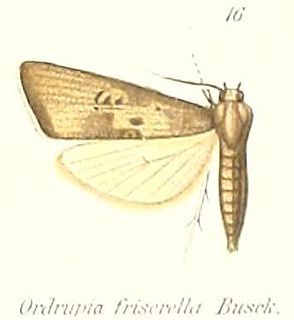Related Research Articles

Copromorphidae, the "tropical fruitworm moths" is a family of insects in the lepidopteran order. These moths have broad, rounded forewings, and well-camouflaged scale patterns. Unlike Carposinidae the mouthparts include "labial palps" with the second rather than third segment the longest. With other unusual structural characteristics of the caterpillar and adult, it could represent the sister lineage of all other extant members of this superfamily. The genus Sisyroxena from Madagascar is also notable for its unusual venation and wing scale sockets.

Epermeniidae or the fringe-tufted moths is a family of insects in the lepidopteran order with about 14 genera. Previously they have been divided in two subfamilies Epermeniinae and Ochromolopinae but this is no longer maintained since the last group is probably hierarchically nested within the first. They are presently placed in their own superfamily but have previously been placed among the Yponomeutoidea or Copromorphoidea with which they share some features. Their systematic placement among the apoditrysian group "Obtectomera" is however uncertain. They show some morphological similarities to the "plume moths", for example the wing fringe has similar groups of scales. There are also some similarities to Schreckensteinioidea, for example spiny legs and at least in some species an open-network cocoon. The genus Thambotricha from New Zealand may be the sister group of all other extant members. The most important genera are Epermenia, Ochromolopis and Gnathifera. The group has been extensively revised and catalogued by Dr Reinhard Gaedike.

Urodidae or "false burnet moths" is a family of moths in the lepidopteran order, representing its own superfamily, Urodoidea, with three genera, one of which, Wockia, occurs in Europe.
Harpagidia is a genus of moths in the family Gelechiidae.

Autosticha is a genus of gelechioid moths. It belongs to the subfamily Autostichinae, which is either placed in the concealer moth family (Oecophoridae), or in an expanded Autostichidae. It is the type genus of its subfamily. Originally, this genus was named Automola, but this name properly refers to a fly genus in family Richardiidae.

Dichomeridinae is a subfamily of moths in the family Gelechiidae.
Elachista vastata is a moth in the family Elachistidae. It was described by Edward Meyrick in 1932. It is found in India.
Agonopterix phaeocausta is a moth in the family Depressariidae. It was described by Edward Meyrick in 1934. It is found in Japan.
Agonopterix cynarivora is a moth in the family Depressariidae. It was described by Edward Meyrick in 1932. It is found in Morocco.

Eucosma abstemia is a species of moth of the family Tortricidae first described by Edward Meyrick in 1932. It is found in the United States, where it has been recorded from Colorado, Arizona and California.
Agonopterix taciturna is a moth in the family Depressariidae. It was described by Edward Meyrick in 1910. It is found in the Himalayas, the Russian Far East and Japan.
Brachmia planicola is a moth in the family Gelechiidae. It was described by Edward Meyrick in 1932. It is found in Tamil Nadu, India.
Dichomeris horoglypta is a moth in the family Gelechiidae. It was described by Edward Meyrick in 1932. It is found on the Japanese islands of Honshu, Shikoku and in Korea.
Dichomeris hoplocrates is a moth in the family Gelechiidae. It was described by Edward Meyrick in 1932. It is found on the Japanese islands of Hokkaido, Honshu, Shikoku and Kyushu.
Dichomeris metuens is a moth in the family Gelechiidae. It was described by Edward Meyrick in 1932. It is found on Java in Indonesia.
Dichomeris microdoxa is a moth in the family Gelechiidae. It was described by Edward Meyrick in 1932. It is found on Java in Indonesia.
Nothris hastata is a moth in the family Gelechiidae. It was described by Edward Meyrick in 1918. It is found in north-eastern India.
Harpagidia amplexa is a moth in the family Gelechiidae. It was described by Edward Meyrick in 1925. It is found in China in Guangdong and Hong Kong.
Ethmiopsis tegulifera is a moth in the family Gelechiidae. It was described by Edward Meyrick in 1932. It is found in the Russian Far East (Ussuri), Korea and Japan.
Anarsia bipinnata is a moth in the family Gelechiidae. It was described by Edward Meyrick in 1932. It is found in the Russian Far East, Korea and Japan.
References
- ↑ Beccaloni, G.; Scoble, M.; Kitching, I.; Simonsen, T.; Robinson, G.; Pitkin, B.; Hine, A.; Lyal, C., eds. (2003). "Harpagidia acanthopis". The Global Lepidoptera Names Index . Natural History Museum . Retrieved May 25, 2018.
- ↑ Savela, Markku, ed. (May 20, 2014). "Harpagidia acanthopis (Meyrick, 1932)". Lepidoptera and Some Other Life Forms. Retrieved August 30, 2020.
- ↑ "ソバカスキバガ Gelechia acanthopis Meyrick, 1932". みんなで作る日本産蛾類図鑑[An Identification Guide of Japanese Moths Compiled by Everyone] (in Japanese). Retrieved August 30, 2020.
| This article on a moth of the subfamily Dichomeridinae is a stub. You can help Wikipedia by expanding it. |